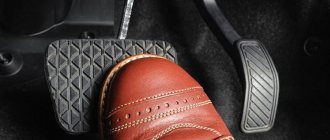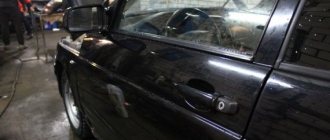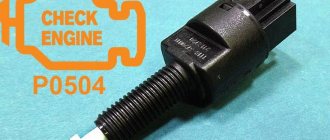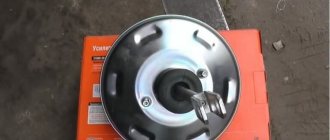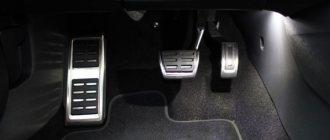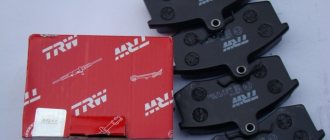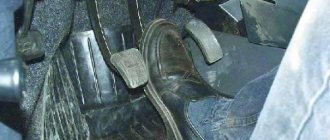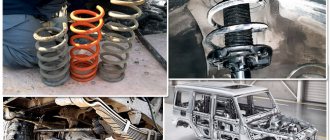It is known that the safe operation of each car directly depends on the correct operation of the braking system. The driver may notice that at some point the car brakes worse, unusual sounds appear during braking, the brake pedal fails, the brake pedal becomes hard or soft, etc.
In any case, if the brake pedal is pressed firmly or the brake pedal is soft and bad car brake, the operation of the car should stop immediately, determine the cause and solve the problem. Below we take care of why the brake pedal is hard, the brakes are too soft, or the brake pedal is alternately soft and tight.
The brake pedal has become hard: the reason
Thus, during operation, you can determine that the brake pedal has become hard, medium or too soft. The reasons for a tight pedal, that is, a situation where a car has a too hard brake pedal, can be either the design of the car or a malfunction. In other words, a hard brake pedal may be normal for some car models. However, if the brakes become hard for another reason, repairs are necessary.
To transfer pressure, brake fluid is poured into the system. The fluid is carried through steel pipes and rubber hoses from the main brake cylinder to the brake wheel cylinders. The brake pump with its pistons exerts pressure on the brake terminals, pushing the brake pads onto the disc or brake drum.
If the brake pedal is too hard or not depressed, it could indicate a problem with the vacuum assist system. Please note the following faults:
- Failure limit switch for vacuum brake support. Replacing the limit switch solves the problem;
- The vacuum assist system also has a special check valve. If the valve sticks or does not work, a specific element must be replaced;
- The VFT may also be equipped with a clogged air filter, which prevents contaminants from entering the layout. If the filter is clogged, it will also cause the brake pedal to become clogged;
- The auxiliary device also has a special check valve. If the header is clogged, replace the element;
- Often the cause of a stiff brake pedal after a few presses or a stiff brake pedal after parking is the brake support membrane. The VFT membrane is torn or cracked and will replace the entire amplifier;
- At the same time, what can happen is that fuel gets into the support chamber (often due to a damaged corner), which also immediately affects the brake pedal;
- One of the common causes of a hard brake pedal that won't press down is the cable that connects the intake manifold to the mounting assembly. Said hose consumes and deforms, meaning it may need to be replaced over time. It could also be that it is loose on the connector. In this case, the problem can be solved by tightening;
- The list is complemented by the use of contaminated brake fluid, which has lost its properties, introducing other fluids to the brake cylinders, as well as swelling of the seal. To fix the problem, replace the gaskets and flanges (brake cylinder repair) and replace the brake fluid. In some cases, it is necessary to replace all brake cylinders.
Malfunctions of the "vacuum"
A vacuum brake booster (VUT), or simply a “vacuum booster,” creates in the vehicle’s vehicle the pressure necessary for their proper operation.
If the amplifier is not working well, the pedal simply won't push through. Since the vacuum booster is a rather complex part consisting of many components, a malfunction of any of them can lead to this situation. And since a breakdown of an amplifier component, as a rule, requires its replacement, correct diagnostics will help save the car owner not only time, but also money.
If the filter element of the “vacuum tank” is clogged, it is enough to replace it so that the amplifier begins to function normally again. This also applies to a damaged vacuum booster diaphragm, and problems with the tip or check valve. It is enough to replace one damaged component, and the vehicle will act like new again. It is important to accurately diagnose what exactly needs to be changed.
Sometimes no major replacements are required at all. For example, in a situation where the vehicle is depressurized. The seal can be broken in two cases: either the hose between the “vacuum reservoir” and the intake manifold is damaged, or the clamps are loose. And if in the first case replacing the hose is still necessary, then in the second it is enough to tighten the clamps. This can also be done at a car service center, but the car owner is quite capable of dealing with such a problem on his own.
But it happens that the unsuitability of only one component completely renders the VUT unusable. This most likely occurs in a situation where vehicle malfunctions are ignored for a long time. As a result, a badly damaged valve moves to such a position that it disables the entire “vacuum tank”. An example is damage when a valve jams in the amplifier, and the latter has to be completely replaced. This is one of the most expensive types of vehicle repair.
If the brake pedal is pressed hard: diagnostics
As you can see, a tight brake pedal is often caused by problems with vacuum support. This way you can quickly check your work on the site.
To diagnose VUT, you can use two methods. In the first case, start the engine so that the adapted vacuum device begins to work. Usually the pedal is soft, and after two or three strong brake presses the engine speed increases briefly.
Another way to check the brake pedal is to press it several times with the engine off. Typically the pedal should be soft for 2-3 presses, then it becomes hard. Then press the brake and start the engine without releasing the pedal. The pedal should go down after the engine starts. If not, then you should also look for VUT failure.
How to make sure the vacuum booster is working properly
First you should do a visual check. Make sure there are no brake fluid leaks and the booster housing is not damaged. Check the integrity of the hoses and the tightness of their connections to the fittings. If necessary, tighten the clamps.
A hissing sound that occurs when you press the brake pedal may indicate a leak. This hissing often persists for some time after the engine is turned off and then it can be heard quite clearly.
There are several ways to check the performance of the vacuum booster.
- The engine must be stopped. Press the brake pedal 6-7 times in a row to equalize the pressure in the booster chambers, and then squeeze the brake all the way and start the engine in this position. If the amplifier is working properly, a vacuum will appear in the system. Due to the pressure of the diaphragm, the rod will move, pulling the pusher along with it. And since the pusher is mechanically connected to the pedal, it will lower slightly, and this can easily be felt with your foot. If this does not happen, it means that a vacuum has not arisen in the system. If you have any doubts, try the second method.
- Turn on the engine, let it idle for a few minutes, then turn it off. Press the brake fully two or three times and release the pedal. If the vacuum booster is working normally and there is no air suction, then the first one or two presses will be soft, and the subsequent ones will be noticeably tighter. If you don't notice any difference in the pedal travel, then there is a problem with the amplifier.
- With the engine running, depress the brake pedal and, while holding it down, turn off the engine. If you now remove your foot from the pedal, it should remain in the lowered state for some time, thanks to the remaining vacuum in the vacuum chamber of the amplifier.
Soft brake pedal: reasons
Once you've figured out why your brake pedal may be hard, pay attention to the equally common problem of the brake pedal becoming soft. Then the brakes may be weak and faulty, which is just as dangerous as a hard pedal.
In extreme cases, when the brake pedal is depressed, it may not rise or drop to the floor during braking. Of course, if the pedal is “wrapped” into the bushing, owners wonder what is the cause of the breakdown, why the pedal is soft after pumping the brakes, and how to make the brake pedal harder.
If bleeding has already been done, there is a high probability that mistakes were made, there are undetected faults, brake fluid leaks, etc. For example, drivers often encounter the problem of a soft pedal after replacing the brake pads, a damaged brake pedal after replacing the brake fluid, a damaged brake pedal after bleeding, but the fluid does not drain, etc.
One way or another, the main reason is that the pressure in the brake system is low. Lines are chipped and cracked, brake cylinders may also have problems, and contaminated brake fluid can damage the brake cylinder surface. It is possible that the brake pistons may jam.
It is necessary to check connections, fittings and other elements in parallel, since even a few drops of brake fluid leakage will not affect the level in the reservoir, and air enters the system, which is caused by soft pressing of the pedal.
It should also be taken into account that if some elements of the brake system have been replaced (discs, pads, drums, brake cylinders, etc.), then the braking efficiency in this case will be slightly lower until you get used to the parts. . In this case, the brake pedal may also be softer than usual for several tens of kilometers, or the brake pedal will be soft at first and then too tight.
If the brake fluid is dirty, old and worn out, it may boil when heated. This can cause the brake pedal to break or become too soft (“cotton-wound”). This situation is so dangerous that the so-called “floating” character can be a problem. If you notice these symptoms, you should start with a complete brake fluid change.
In the article:
- The pedal has become too hard
- How to make sure the vacuum booster is working properly
- The brake pedal is too soft
- Results
The braking system is the most important component of any vehicle.
Automotive designers pay special attention to brakes, realizing that safety on the road and people’s lives depend on their impeccable operation. The brakes of modern cars are quite reliable, however, you need to remember that any parts during operation are subject to mechanical, thermal, chemical and other types of loads, and therefore wear out and may fail. Brake system parts are no exception, only in this case the cost of a malfunction can be very high. Certain signs that appear during braking can warn that something is wrong with the brakes - extraneous sounds or strong vibrations, the car pulling to the side, uneven or noticeably decreased braking efficiency and an increased braking distance. But the first thing people usually pay attention to is the behavior of the brake pedal. It can become too tight, so that you have to press on it with force, or, on the contrary, it can suddenly turn out to be too soft, or even fail completely. All this complicates braking and can lead to serious consequences. Let's talk in more detail about what causes such symptoms and what to do in such situations.
Why is the brake pedal higher than the gas pedal?
Motorists often wonder why in many models all the pedals in the car are not in the same plane. Typically, in cars with an automatic transmission, the brake pedal is significantly higher than the accelerator pedal. On manual transmission cars, the clutch and throttle are often lower than the brake.
It should be noted that there is a lot of controversy, a lot of speculation and conjecture on this matter. Some drivers say it's inconvenient, others complain that if the pedals were flush it would be easier to control the car, etc.
We should also add that some owners find that the brake pedal is placed higher to increase pedal travel and also because more force (leverage) is required.
Swelling of rings in cylinders.
The condition of the brakes largely depends on what kind of brake fluid is used during operation. If it is a product of a well-established company, the vehicle is rarely damaged or disabled. But if the fluid is of poor quality, one or more cylinders may not function well due to their O-rings swelling. The same thing happens when fuel and lubricant gets on the ring.
Previously, especially in the era of the Soviet automobile industry, the car owner sooner or later had to sort out the working cylinders. Such an activity was long and burdensome even for professionals. But now hardly anyone will do this if the vehicle is faulty. From the point of view of saving time, it is much easier to change them, and at the same time the brake fluid. However, you can avoid unnecessary financial costs if you use high-quality, albeit expensive, liquid from the very beginning, since repair costs are always higher.
Let's sum it up
Therefore, it is obvious that any abnormality in the braking system (for example, a soft brake pedal, a hard brake pedal, or a combination of problems) requires immediate diagnosis. After the fault has been identified, it is necessary to properly fix the problem.
It is also necessary to promptly replace the fluid, pump up the brakes, check the brake lines for defects and leaks, promptly install new brake pads, discs or drums, lubricate the brake caliper guides, etc. This approach will allow you to safely operate your vehicle and obtain high-quality performance of the braking system in any conditions.
